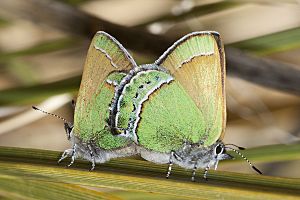Sandia hairstreak facts for kids
Quick facts for kids Sandia hairstreak |
|
|---|---|
 |
|
| Mating in New Mexico | |
| Scientific classification | |
| Kingdom: | |
| Phylum: | |
| Class: | |
| Order: | |
| Family: | |
| Genus: |
Callophrys
|
| Species: |
C. mcfarlandi
|
| Binomial name | |
| Callophrys mcfarlandi Clench & Ehrlich, 1960
|
|
| Synonyms | |
|
|
The Sandia hairstreak (Callophrys mcfarlandi) is a special type of butterfly that lives only in parts of North America. It's quite rare and doesn't live in many places. This butterfly was first found in 1958 near Albuquerque, New Mexico, by a student named Noel McFarland. The Sandia hairstreak became one of the official state insects of New Mexico in 2003.
About the Sandia Hairstreak
The Sandia hairstreak is a fairly small butterfly. Its wings do not have tails and spread about 2.9 to 3.2 centimeters (1 and 1/8 to 1 and 1/4 inches) wide. Female butterflies usually have reddish-brown wings on top with a thin black edge. Males are typically brown.
The underside of the wings for both males and females is often greenish-yellow. It has a line near the middle that is bordered with black. These butterflies can look a bit different from each other. This is called polymorphism. However, a simple way to spot them is that they are small, gold, and green. They live among beargrass plants. Their caterpillars are pink, lavender, and white, and they eat beargrass flowers. This makes both the butterfly and its caterpillar easy to identify.
Life cycle
The Sandia hairstreak butterfly lays its eggs on the stalks of a plant called Texas sacahuista (Nolina texana). The caterpillars of this butterfly usually eat only this plant. They munch on both its flowers and its fruit.
Scientists found that these caterpillars could also be raised in a laboratory on a different plant, Lotus scoparius. This suggests that the butterfly might have lived in more places a long time ago. Adult Sandia hairstreaks drink nectar from the same plants that their larvae (caterpillars) eat.
Where They Live
The Sandia hairstreak lives in yucca- and agave desert areas. You can find them in the Southwestern United States, including southeast Colorado, New Mexico, and western Texas. They also live in northeast Mexico.
New Mexico's State Butterfly
The Sandia hairstreak was chosen as the official state butterfly of New Mexico in 2004. The lawmakers in New Mexico felt that this butterfly was "uniquely New Mexican," even though it lives in other places too.
They had many reasons for choosing it as a state symbol:
- An official butterfly adds beauty and variety to the state's symbols.
- Many other states also have official butterfly symbols.
- Butterflies make the environment more beautiful.
- Naming a butterfly helps tourism and the economy in New Mexico. It brings attention to the butterfly and encourages scientific research.
- It helps teach people about butterflies and their homes.
- Butterflies are important pollinators for wildflowers and farm crops. Naming a butterfly helps protect nature.
- Children love butterflies, and this symbol brings joy to kids in New Mexico.
- The Sandia hairstreak shows how people in New Mexico can live well in a semiarid climate. This is a place where there can be floods or droughts, and the land is beautiful but rough.
- Children can easily find the Sandia hairstreak among the native beargrass in New Mexico's open spaces, towns, and cities.
- The Sandia hairstreak is native to New Mexico and does not migrate. It stays in the New Mexico landscape all year. No other state has chosen it as their state butterfly.

